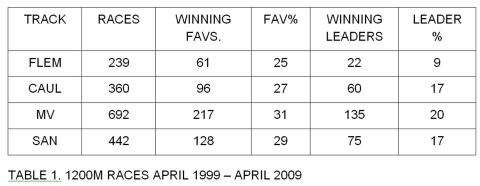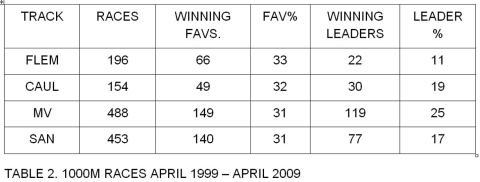Mention straight course racing and substantial wager in the same sentence, and I’m sure a fair percentage of the nation’s serious hard core punting brigade might just start to twitch a little.
The straight course racing to which I’m referring is, of course, the sprint races run at Australia’s most identifiable racecourse Flemington. Since the demise of Adelaide’s Victoria Park, which had a straight 1000m course, Flemington is now the only metropolitan track which hosts straight racing.
All racing under 1400m is run in a straight line down Flemington’s famous straight, although many racing pundits might like to eke that out a little and append the following: famous straight – for losing money.
Jumps racing and 3200m events have had more than their share of detractors over the years, but it would seem that the straight sprint racing at Flemington easily holds the mantle of the nation’s most maligned type of racing in recent times.
Sky Racing’s form analyst Ron Dufficy has on more than one occasion been fiercely critical of the Flemington straight course, with not so flattering adjectives of ‘Lottery, Joke and Heavy Bias’ freely bandied about in discussion. Dufficy is not a lone voice when it comes to criticism of the straight course; there is a growing chorus of disgruntled punters and highly credentialled form analysts who are at constant odds as to which way the track will play on any given day.
To see whether these rumblings held any justification I decided to put Flemington’s straight course racing under the microscope. I would take a comparative look at these straight sprint races against similar distance racing at Melbourne’s other three metropolitan tracks and try to isolate any anomalies that the Flemington course might produce.
If the statistics exhibited results that were a departure from the median of other sprint races in Victoria, then I’d try to resolve reasons for the departure and hopefully formulate a strategy, or at least a rule of thumb that would enhance our wagering in future straight racing.
Before embarking on this inquiry I had always held two preconceived ideas on straight course racing, which were based on several decades of observation. One was that on many occasions there was a distinct bias present between the inside and the outside of the track, and the other was that it was a leader’s graveyard.
Let’s look at some statistics gathered over a 10 year period and then touch upon any issues raised. For the benefit of this enquiry I have only looked at 1200m and 1000m races.


As I thought they might be, my suspicions about leaders at Flemington have been statistically endorsed; okay, it mightn’t be a leader’s graveyard, but in table 1 we can see that leaders virtually do twice as better at Melbourne’s other tracks than Flemington over the 1200m course. Flemington fares a little better over the 1000m course but as is the case in table 1 is still at the bottom. Now we need to examine why.
My own slant as to why leaders perform comparatively poorly in straight racing is predominately twofold. The first is a factor that in most cases wouldn’t come into consideration at other tracks, and that is the prevailing wind conditions.
When leaders have to race into even a slight head wind up the Flemington straight course it can become extremely taxing, due to the fact the leaders get no respite at any stage of the race and must lead the bunch from barrier release to finish. In racing around the bend at least leaders get some respite and would probably only have to contend with headwinds for about one-third of the race.
The second factor is that leaders down the straight do not have the sometime luxury of their dangers being trapped wide throughout and obliged to cover plenty of extra ground. All horses race in a straight line; theoretically none are forced to cover extra ground. So a leader’s advantage over other runners has been removed from the equation.
When trying to get a handle on certain aspects of racing I normally raise the particular issue with my racing peers to get a consensus of opinion on the point at hand, then mull over the varied responses. I posted the issue on leaders on an Internet forum, and generally the response fell pretty much into line as to the previous paragraph, but one interesting point raised that I was unaware of was that there is quite a significant fall in the first 400m of the Flemington straight track and horses that are fired out of the barrier are quite often encouraged to run a faster first sectional of the race than at other courses due to the prevailing landscape.
Then the track begins to rise just prior to the linking up with the round course, and levels out at the finish. So the tendency to overdo things early is later exacerbated by the uphill climb and as a result leaders can easily and most often do tire.
In 1200m races, the table also reveals that favourites have a winning percentage less than at any other Victorian metro track. Flemington fares much better with favourites over the 1000m course. With the 1200m races, perhaps punters are looking at horses with the wrong constitution for this course.
I looked at the last 20 Newmarket Handicaps and also the last 20 Salinger Stakes; the common thread was that the predominance of winners were all multiple winners of races longer than 1200m. An old saying of back a good miler to win a Newmarket would at least seem to hold some sort of credence here. Apart from animals with a proven track record over the Flemington 1200m, it might be a good idea if we started treating these races as 1400m events, and process the form accordingly.
Before we get into the issue of track bias, I need to tell you there are two types of bias in horseracing, one is actual bias and the other is perceived bias. Too often punters fall victim of their own misconceptions by assigning track bias to a meeting based on insufficient or misread data. More often than not you almost need to see at least half the card before having any chance of assessing bias.
It’s why this has become the bane of the modern punter. So, is there track bias down the Flemington straight?
The answer is an overwhelming yes. This bias has been around for a hell of a lot longer than the current rumblings.
I can remember back in the 70s when the word bias was hardly in the racing vernacular that for many years the Grandstand side, or ‘down the roses’ (as we called it in those days) was many lengths faster than the flat side.
Very little was written about it, but smart punters knew. A good horse in form drawn wide against its assessed dangers drawn the flat side almost became a moral. I cashed in on this phenomenon for many years.
Unfortunately, much of modern track bias is created by the increased artificial watering of tracks to create a contrived dead reading on race mornings, as racing officialdom has removed fast rated tracks. Whether the track is watered naturally or artificially, most tracks never dry out evenly creating fast and slow lanes.
One of the anomalies at Flemington is that although there is basically no discernible penetrometer difference between the inside and the outside, a perceived bias seems always prevalent, particularly as assessed by riders, who will invariably all head to the same side of the track. In capacity fields however, they will on most occasions still split into two divisions.
Now comes the problem in the case of actual bias, which can develop problems when doing future form.
It would be unfair to rate horses on the slow side of the track against the runners with the favourable bias for future racing. The best way around this is to treat each side of the track as a separate race, to eliminate the false margin scenario created by the track bias.
On the basis of this research I’ll put forward the following three rules of thumb for consideration for Flemington’s straight course:
- If possible, avoid backing leaders, statistically they have a very poor record, and in certain wind conditions virtually have no hope due to the taxing workload.
- When doing the form for 1200m races, unless a galloper has a proven record, treat the race as a 1400m event and do the form accordingly. Historically most horses need a stronger constitution for this 1200m route as opposed to other tracks
- When the field splits into two divisions, and you have identified actual bias between the inside and outside, then treat each division as a separate race for future form analysis.
So what do we make of all this? Well I suppose the easiest solution would be to leave straight racing alone, unless you have an accurate determination of any biases associated with this course. With wind conditions, horse constitution consideration, and two races in one, is it any wonder punters have been driven around the bend.
By Ken Blake
PRACTICAL PUNTING – JUNE 2009